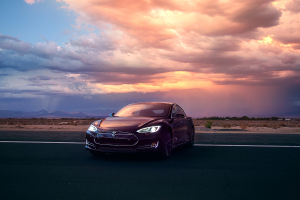Happy 50th!
If you’re not reading this on feedly or some other RSS reader, then you may have noticed a slight change in the appearance of this blog. In honour of the 50th issue of This Week in Tomorrow, we’ve gone for a new look. It hopefully fixes some of the formatting problems experienced by mobile readers, as well as adding what I think is a fresh look to the site. The theme is called “Suits,” and the wonderful image being used in the header is a beautiful Hubble shot of 30 Doradus, a star-forming region in the Large Magellanic Cloud. The picture is a part of the NASA Goddard Space Flight Center’s flickr feed, and has, like almost all of the images used on this site, been released under a Creative Commons Attribution 2.0 Generic license. Check out the feed for more amazing shots. And now: the news!

Blue Nobel
This week the Nobel Prize winners for 2014 were announced, and what Nobel announcement would be complete without a little controversy. On Tuesday, the Nobel Prize for Physics was awarded to three scientists, two in Japan and one in the US, for the invention of the blue LED. Shuji Nakamura, of the University of California, Santa Barbara, and Isamu Akasaki and Hiroshi Amano, both of Nagoya University in Japan, will receive the prize “for the invention of efficient blue light-emitting diodes which has enabled bright and energy-saving white light sources”. The only problem, reports Boston-area news website Bostinno, is the absence of the name Theodore Moustakas from the award:
Just this January, twenty-five companies settled lawsuits brought by Boston University over patents held by Professor Moustakas (and therefore the university) over his part in the invention of the device, while a dozen more lawsuits are ongoing. An article from 2002 sheds a little more light on the subject:
The Nobel Committee is not known for reconsidering its decisions, but it’s worth remembering Moustakas’s name, if only for posterity’s sake.

Tesla’s Supercar
This week Elon Musk fulfilled his promise to “show us the D”: D, in this case, standing for “dual.” The new versions of the Model S now come with a few new features, most notably two motors, one in the front, and one in the back. The new Model S P85D packs a whopping 691bhp, 687lb-ft of torque, and a straight-line zero-to-sixty of 3.2 seconds: that’s the same as a Porche 911 Turbo and a Lamborghini Huracán LP 610-4. It also features some of the most advanced sensor arrays of any production vehicle — it’s not “self-driving” yet, but it’ll change lanes for you (Jalopnik has the rundown). IndefinitelyWild has a write-up of the tech that’s packed into the new car and how it works, and the Verge has a write up of what it feels like to be in one. But of course, you might need to save up a little. Unlike the Model 3 (coming in 2017 for an estimated $35,000), this one might take a little saving up: the base model is going to run you roughly $120,000. But then, all things considered, that’s not a bad pricetag for a supercar.
Fusion
Fusion is the energy of the future, goes the old saying, and it always will be. Promises of the mostly clean nuclear reactors have been many, but none have ever been filled. But it’s starting to look like the periodic announcements out of ITER and the NIF are going to be outpaced by smaller, lighter, and more innovative solutions. ITER, the International Thermonuclear Experimental Reactor, was conceived in 1988. The world’s largest planned tokamak reactor, it’s designed to operate at a large enough scale to make back the energy spent to start it, reaching the so-called “break even” point. But at current estimates, it’ll be 2027 before they start deuterium-tritium reactions. The NIF, the National Ignition Facility, was begun in 1997. The plan was to use powerful lasers to compress the raw materials for fusion into such a small space as to create momentary nuclear fusion, but successes have been few and far between.
Amid all the apparent stasis, then, it’s surprising to read that engineers at the University of Washington have announced that they’ve designed a new kind of reactor that could generate electricity cheaper than using coal. The two engineers responsible, professor Thomas Jarboe and doctoral student Derek Sutherland, have apparently already built a 1/10th scale prototype, although the work is years from completion:
I guess we’ll wait and see. Their results will be presented at the IAEA’s Fusion Energy Conference on October 27.
IBM Solar
The International Business Machines Corporation (that’s IBM to you, Big Blue to its friends) isn’t just making supercomputers for chess and Jeopardy anymore. Now they’re getting into solar power. In partnership with a Swedish company called Airlight Energy, the blue-chip computer maufacturer is developing solar-thermal generators that could operate at 80% efficiency. The High Concentration PhotoVoltaic Thermal (HCPVT) system harvests heat and light simultaneously at a small enough scale to be useful for groups of homes or small-scale commercial or industrial use, furthering the vision of the future electrical grid as a “distributed” one. Check out Phys.Org for the details.
Himawari 8
The Japan Meteorological Agency (JMA) sent a weather satellite into orbit this week that promises better tracking of developing and ongoing typhoons in the Eastern Hemisphere. Launched from Tanegashima earlier this week atop an H-IIA rocket, the Himawari 8 satellite was built by Mitsubishi Corp. and features an imager built by Indiana-based Exelis Geospatial Systems that should be able to scan the hemisphere every ten minutes. It will take its place in a network of weather satellites operated by the agency. Spaceflight Now has more on the story.
Alyssa Carson
Keep that name in mind: it might be one for the history books. Alyssa Carson may only be 13, but she’s first person to attend all three of NASA’s world space camps, and she’s determined to be the first person on Mars. The teen from Baton Rouge, Louisiana, is about the right age, if Elon Musk’s plans pan out. Though she might have to settle for the first person on Mars to survive to tell the tale, if MIT’s new study of Bas Lansdorp’s Mars One program is right (it says the private venture will probably kill all the colonists, mostly via starvation). But seriously: check this kid out. She’s pretty cool.
Best of the Rest
There was a lot to see this week: Toshiba’s got a set of smart glasses that don’t have a prism; Sierra Nevada Corp has teamed up with Stratolaunch to put Dream Chaser into suborbital space; Sikorsky’s made a new military helicopter that can cruise at 253 miles an hour; Transport for London’s designed new autonomous subways for deployment around 2022; a toy company has made something weird called “Kinetic Sand,” which is fun to watch if nothing else; scientists have found a pulsar that’s just too bright to make sense; and a group of anthropologists have found that societies with more women aren’t necessarily any less violent, which really shouldn’t surprise anyone, but there you go.
That’s all for now. Have a great week, everyone.

